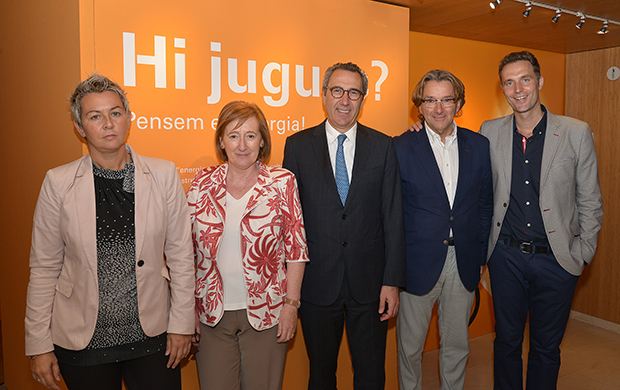The Gas Natural Fenosa Foundation’s Gas Museum opens the exhibition “Want to play? Let’s think about energy!”
This exhibition consists of different interactive spaces for hands-on experimentation to discover the secrets of two of the energy sources we use most in our homes: gas and electricity.
The exhibition, which can be seen until 28 February 2016 at the Gas Museum in Sabadell, was created in partnership with the well-known presenter of scientific content, Dani Jiménez.

Today in Sabadell the Director General for Secondary School Education in the Generalitat de Catalunya, Teresa Pijoan, the Director General of the Gas Natural Fenosa Foundation, Martí Solà, the Director of the Gas Museum, Eva Buch and the curator of the exhibition, Dani Jiménez, opened the exhibition “Want to play? Let’s think about energy!”
The show, which can be seen until 28 February 2016 at the Gas Natural Fenosa Foundation's Gas Museum, lets visitors discover the secrets of gas and electricity as energy sources through interactive spaces with fun educational experiments designed by the science presenter Dani Jiménez.
With a focus on teaching, the exhibition lets visitors experience the nature, creation and distribution of these energies which are so vital to everyday life. It also considers how energy was created in the past, without modern technology, which tools we currently use to produce energy and bring it to our homes, the economic costs of energy, and the efficiency habits we need to avoid wasting it.
Interactive modules
The exhibition comprises interactive modules for experimenting with energy, divided into five themed sections: Elèctricament sorpresos (about electricity), Gasosament atents (about natural gas), Et comuniques gràcies a l’energia (about the sun), Energia per viure (about thermal energy emitted by our bodies) y El miracle de la luminescència (about the phenomenon of phosphorescence).
The experiments include a dark room in which visitors can draw using the light from a lantern; a thermal imaging camera, with which you can see the infra-red radiation given off by the human body and see how we are a heat machine in operation; a pedal-powered car that generates electricity to light some bulbs; and an experiment with tubes of different materials down which a neodymium magnet is dropped in order to see that some fall more slowly than others based on whether the material is more or less conductive.
The exhibition's experiments also include an aquarium with two bulbs –one incandescent and one LED– that, when they are turned on, show that the incandescent heats up slowly because of the small bubbles; a flexible hose that shoots out air to steer a ball and see how natural gas travels from the natural deposits to our homes; a balloon full of air that, when submerged in liquid nitrogen, changes state and occupies much less space; and a Van Der Graff generator to see how electrons order themselves inside a battery.
The exhibition curator, Dani Jiménez
A physicist and a science presenter, specialising in the use of experiments as a learning tool, Dani Jiménez has worked in various media, including Televisión Española, Cuatro and TV3, and is the author of the books Ciencia a un euro, Ciencia a dos euros and ¿Por qué algunos pimientos pican y otros no? He is now the director of the educational content company CreaCiencia, presents and advises the TV programme “Dinamiks” on Club Súper 3, and contributes to Catalunya Radio and the magazine “Muy Interesante”.
The Gas Natural Fenosa Foundation
The Gas Natural Fenosa Foundation, founded in 1992, targets its activity at the promotion of information, training and increased social awareness on improving energy efficiency and technological innovation in the field of energy while respecting and protecting the environment, and promotes cultural activities through the Gas Museum aimed at preserving and spreading knowledge about the historical and cultural heritage of the sector. It also carries out an export support programme aimed at small- and medium-sized enterprises. Its international operations take place in Algeria, Argentina, Brazil, Colombia, Costa Rica, Mexico, Morocco, Italy and Moldova.
The Gas Museum is a cultural centre combining a permanent exhibition with the organisation of temporary exhibitions, conferences, an educational programme for schools, activities for children and adults, and film and music seasons. Since it opened in 2012, over 94,000 people have visited the temporary exhibitions and taken part in the special activities organised by the museum.
Sabadell (Spain), 17 Jun 2015
Share